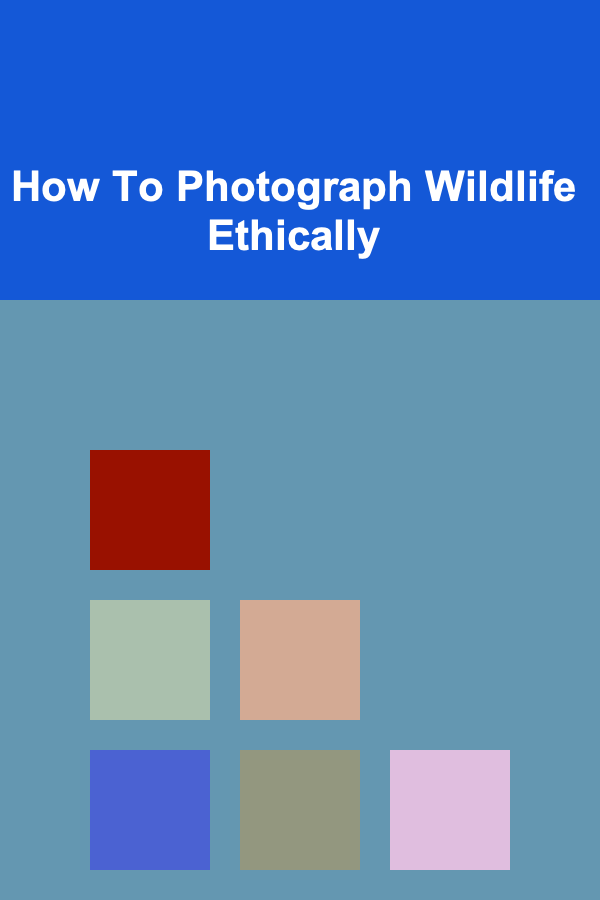
How To Photograph Wildlife Ethically
ebook include PDF & Audio bundle (Micro Guide)
$12.99$9.99
Limited Time Offer! Order within the next:

Wildlife photography is a unique art form that requires patience, skill, and a deep respect for nature. It's not just about capturing stunning images of animals; it's about telling a story and conveying the beauty and complexity of wildlife while ensuring that your actions do not harm the creatures you are photographing. Ethical wildlife photography is a practice that prioritizes the welfare of the animals, their habitats, and the environment, while still allowing photographers to create compelling images.
In this article, we will explore the principles of ethical wildlife photography, discuss the steps photographers can take to ensure they are working responsibly, and provide guidance on how to build a sustainable and respectful relationship with wildlife while still achieving excellent photographic results.
The Ethical Responsibility of Wildlife Photographers
Before delving into practical advice on how to photograph wildlife ethically, it is essential to understand the ethical responsibility that comes with wildlife photography. Nature, in its raw form, is fragile. Wildlife photography, if done carelessly or irresponsibly, can have lasting negative effects on the animals, their ecosystems, and the photographer's reputation. Here are a few critical aspects to consider:
- Respect for Wildlife: Animals are sentient beings with their own natural behavior, and the role of a wildlife photographer is to capture these moments in a way that doesn't disrupt or harm the creatures involved. Disturbing an animal's natural behavior for a photo can be harmful not only to the animal but also to the ecosystem in which it lives.
- Respect for Nature: Wildlife photography isn't just about animals; it's also about their environment. Habitats are delicate and can easily be damaged. For instance, stepping on fragile plants, disturbing nesting sites, or inadvertently introducing pollutants into the environment can have devastating effects on ecosystems.
- Legal and Regulatory Compliance: Many places where wildlife can be photographed are protected by law. National parks, wildlife reserves, and other protected areas have strict regulations in place to minimize human impact. Photographers must follow these laws, not only out of respect for nature but also to preserve these places for future generations.
- Avoiding Stress and Harm to Animals: Ethical wildlife photographers are mindful of the stress their presence might cause to animals. Some species are easily stressed by human presence, and even slight disturbances can result in behavioral changes, which might negatively impact the animal's health, safety, and overall well-being.
The Dangers of Unethical Wildlife Photography
Unethical wildlife photography can have several negative consequences. These may range from minor disruptions to significant environmental damage. Here are some examples:
- Disturbance to Natural Behaviors: Approaching animals too closely or using baits to attract them can cause stress or alter their natural behaviors. For example, birds might abandon their nests, or predators may shift their hunting patterns. The consequences of such actions can have a domino effect on the species' survival and ecosystem balance.
- Habitat Destruction: Wildlife photographers sometimes unintentionally cause habitat destruction by trampling on fragile vegetation, disturbing nesting sites, or creating noise pollution. Such disruptions can lead to long-term damage, and in extreme cases, the degradation of entire ecosystems.
- Injury to the Photographer and Animal: In some instances, unethical practices may endanger both the photographer and the wildlife. For instance, attempting to get a close-up photo of a dangerous animal or trying to get a dramatic shot from a risky angle can lead to injury. More importantly, such behavior can provoke the animal into defensive aggression, which is detrimental to both parties.
- Commercial Exploitation of Animals: Some photographers prioritize profit over ethical standards. Using unnatural methods to entice animals, such as baiting or using distressed sounds to make the animals behave in a specific way, is exploitative and unethical. These actions prioritize commercial success at the cost of animal welfare.
Key Principles of Ethical Wildlife Photography
Ethical wildlife photography revolves around several principles that guide a photographer's actions in the field. These principles should be kept in mind throughout every aspect of wildlife photography, from planning and shooting to editing and publishing.
1. Minimize Human Impact
The primary rule of ethical wildlife photography is to minimize your impact on the environment and the wildlife you are photographing. Here are some strategies to achieve this:
- Respect Distance: Stay at a respectful distance from animals to avoid causing stress or altering their natural behaviors. Use long lenses and zoom capabilities to capture intimate shots without getting too close.
- Avoid Disturbing Animals: If an animal shows signs of distress or attempts to flee, it's important to stop what you're doing and back off. This is an indicator that your presence is causing discomfort, and it's essential to respect their signals.
- No Baiting or Luring: Do not use bait to attract animals. This practice can alter their natural diet, encourage dependence on humans for food, and even increase the risk of diseases. It can also attract animals to dangerous areas where they might be vulnerable to predators or other threats.
- Do Not Feed Animals: Similarly, feeding animals can disrupt their natural behavior, as it may make them reliant on human food sources. This can also affect their ability to forage in the wild and can be detrimental to their health.
2. Be Aware of the Environment
Photographers must be mindful of the environmental impact of their actions. The habitats of animals are often fragile, and it's essential to minimize your footprint:
- Stay on Trails: When in protected areas like national parks or reserves, always stay on designated trails. Straying off trails can trample vegetation and disturb wildlife.
- Be Careful with Equipment: Ensure that your equipment, including tripods and cameras, is not causing any damage to the environment. If you're photographing in a sensitive area, take extra care to avoid damage to delicate plants or fragile ecosystems.
- Take Nothing But Pictures: Leave the environment as you found it. Never remove plants, rocks, or other natural objects from the habitat. Additionally, avoid leaving behind trash or litter in the environment, as this can harm wildlife.
3. Avoid Disrupting Natural Behaviors
One of the hallmarks of ethical wildlife photography is documenting animals in their natural behaviors. Here's how you can ensure you aren't disrupting their actions:
- Observe, Don't Interfere: If an animal is engaged in a behavior that could be disrupted by your presence (e.g., mating, hunting, or nesting), avoid intervening. Your role as a photographer is to capture these moments without altering the natural flow.
- Understand Animal Behavior: It's important to study the species you are photographing. By understanding their natural behavior patterns, you can better predict when and where to photograph them without disturbing their environment.
4. Respect Wildlife Regulations and Guidelines
Every region has specific regulations governing wildlife and protected areas. Adhering to these laws not only ensures that you are photographing ethically but also helps preserve these areas for future generations:
- Follow Guidelines: Always check local wildlife regulations, and abide by the rules when photographing in national parks, reserves, or other protected areas. This includes guidelines related to photography, such as where and when you can take photos and whether flash photography is permitted.
- Respect Wildlife Protections: Some animals or areas are particularly sensitive and are subject to additional protections. If an area or animal species is considered endangered or vulnerable, it's crucial to adhere to stricter guidelines to prevent disturbance or exploitation.
5. Be Honest and Transparent in Your Representation
Photographers have an ethical obligation to represent their subjects truthfully. While it may be tempting to enhance or manipulate images for dramatic effect, this can mislead the public and distort the portrayal of wildlife:
- No Staged Shots: Ethical wildlife photography should not involve staged or manipulated images. Using artificial means to alter a scene, such as changing the background or digitally inserting animals into different environments, detracts from the authenticity of the work.
- Honest Captions: When sharing your photos, always provide truthful captions that describe the context of the image. This includes information on the species, habitat, and any specific actions the animal is performing. Misleading captions or fabricated stories undermine the integrity of wildlife photography.
Practical Tips for Ethical Wildlife Photography
Now that we've discussed the ethical principles of wildlife photography, here are some practical tips to help you capture stunning, ethical wildlife images:
1. Use Long Lenses and Avoid Getting Too Close
One of the most effective ways to photograph wildlife ethically is by using long lenses (such as 200mm, 300mm, or even longer). These lenses allow you to capture close-up images from a safe distance, ensuring that you don't disturb the animals.
2. Research Animal Behavior
Before going out into the field, spend time researching the species you want to photograph. Understanding their behaviors, habitats, and ecological needs will help you approach them with respect and avoid disturbing their natural actions.
3. Use Natural Light
Natural light is ideal for wildlife photography. It creates more realistic and less intrusive images. Try to photograph during the golden hours (early morning or late afternoon), as these times provide softer, warmer light and can yield dramatic effects.
4. Be Patient and Wait for the Right Moment
Wildlife photography requires patience. Instead of attempting to force an animal into a specific position, wait for the animal to exhibit natural behaviors. The key to ethical wildlife photography is capturing moments as they unfold, not manipulating the scene.
Conclusion
Ethical wildlife photography is about more than just capturing beautiful images; it's about honoring the natural world and respecting the creatures you are photographing. By following the principles of minimizing impact, respecting animals and their habitats, adhering to regulations, and being honest in your representation, you can produce stunning, respectful images that inspire others to care about wildlife and nature conservation.
Wildlife photographers have the power to influence public perception of animals and ecosystems, so it is their duty to ensure that their work is done responsibly and sustainably. Through ethical photography practices, we can help preserve the beauty of the natural world for future generations to enjoy.
Reading More From Our Other Websites
- [Organization Tip 101] How to Incorporate Crafting into Learning Activities
- [Home Lighting 101] How to Layer Lighting for an Inviting Living Room Atmosphere
- [Home Space Saving 101] How to Build a Vertical Garage Storage System: Tools and Techniques for a Tidy Workshop
- [Organization Tip 101] How to Organize Your Sports Equipment for Kids
- [Screen Printing Tip 101] Step-by-Step Guide: How to Set Up a Home Screen Printing Studio Without a Press
- [Stamp Making Tip 101] From Snapshot to Custom Stamp: Essential Tools & Tips for Perfect Photo-Based Stamps
- [Personal Care Tips 101] How to Apply a Face Mask for Maximum Benefits
- [Simple Life Tip 101] Best Simple‑Living Books Every Aspiring Minimalist Should Read
- [Organization Tip 101] How to Organize Your Bathroom Products for Easy Access
- [Home Holiday Decoration 101] How to Decorate Your Home for the Holidays with Eco-Friendly Materials

How to Create a Checklist for Managing Social Media Crises and Negative Feedback
Read More
How To Use Organic Pest Control Sprays
Read More
How to Understand Grid-Tied vs. Off-Grid Systems
Read More
How to Leverage Your Existing Network for Referrals
Read More
The Profound Power of Consistent Practice: Unlocking Potential and Achieving Mastery
Read More
10 Tips for Improving HVAC Airflow in Older Homes
Read MoreOther Products

How to Create a Checklist for Managing Social Media Crises and Negative Feedback
Read More
How To Use Organic Pest Control Sprays
Read More
How to Understand Grid-Tied vs. Off-Grid Systems
Read More
How to Leverage Your Existing Network for Referrals
Read More
The Profound Power of Consistent Practice: Unlocking Potential and Achieving Mastery
Read More